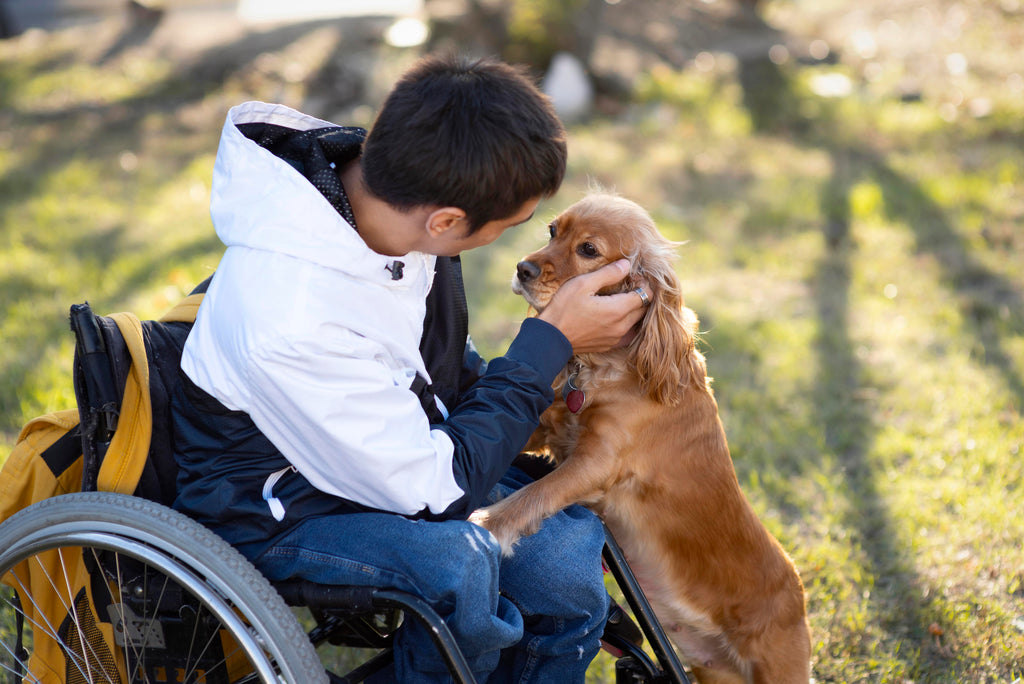Why Foster a Dog
Fostering a dog is an incredibly rewarding experience that goes beyond just offering a temporary home to a furry friend. It’s an act of compassion that can transform the lives of both the dog and the foster family. If you've been considering bringing a dog into your life, fostering might be the perfect step to take.

Dogs in Australia Looking For Homes
In Australia, there are approximately 6 million pet dogs, making them (for good reason) the most popular pet in Australian households. Sadly, despite this high number a significant number of dogs find themselves in shelters each year.
Approximately 200,000 dogs enter animal shelters each year, with a substantial portion of them seeking new homes. Unfortunately, due to various circumstances such as overcrowding and limited resources, not all of these dogs find permanent homes quickly opening the critical need for foster families and adopters to step in and provide temporary or permanent care, ensuring these animals receive the love and stability they deserve.
Why Do Some Dogs Need Fostering?
Many dogs need fostering due to overcrowded shelters, where the sheer number of animals often exceeds available space. By providing temporary homes, foster families help alleviate this pressure, reducing the risk of euthanasia and allowing shelters to rescue more animals! Fostering is particularly vital for dogs recovering from illness or injury, as it offers them a quiet, comfortable environment to heal and regain their health.
Behavioural rehabilitation is another critical reason for fostering. Dogs with past abuse or neglect may exhibit fear, anxiety, or aggression, making them unsuitable for immediate adoption. A stable, loving foster home allows these dogs to receive the training and socialisation needed to become well-adjusted pets. Additionally, fostering is essential for puppies and special needs dogs, providing the round-the-clock care and individualised attention that shelters often cannot offer.
Fostering gives rescue organisations the time to find the best possible match for each dog, ensuring a smoother adoption process and a better fit with adoptive families.

9 Reasons Why You Should Foster a Dog
1. Saving Lives:
One of the most significant impacts of fostering is the lifesaving aspect. Animal shelters are often overcrowded, and many dogs face the risk of euthanasia simply because there isn't enough space. By fostering, you provide a safe haven for these dogs, giving them a second chance at life.
2. A Trial Run for Adoption:
Fostering allows you to experience what it’s like to have a dog without the long-term commitment. It’s a great way to see how a dog fits into your lifestyle and whether you’re ready for the responsibilities of pet ownership. If you find that the dog is a perfect match, you may even decide to adopt them permanently, also known commonly amount people that foster as a “Foster Fail”.
3. Making a Difference in a Dog’s Life:
Many dogs in shelters have had rough pasts, experiencing neglect or abuse. By fostering, you provide a loving environment that helps them recover emotionally and physically.
4. Fostering is Flexible:
Unlike adoption, fostering is usually a temporary commitment. This flexibility can be perfect for people who may not be able to commit to a dog for its entire life but still want to make a positive impact. Whether you to choose to just foster over school holidays, between travel or just during a particular busy shelter season, there’s always a need for foster families!
5. Gaining a Unique Experience:
Fostering provides unique experiences that you wouldn’t get from just adopting a dog. You get to meet and care for dogs of various breeds, ages, and personalities. Each dog brings its own story and challenges, teaching you patience, empathy, and resilience.
6. It’s Rewarding:
The sense of fulfilment that comes from fostering is unparalleled. Knowing that you’ve played a crucial role in a dog’s journey to finding a permanent home is incredibly gratifying.
7. Educational Opportunities:
Fostering a dog can be a fantastic educational opportunity for families, especially children. It teaches them about responsibility, compassion, and the importance of caring for animals. It’s a hands-on way to instil values that will stay with them for a lifetime.
8. Emotional and Mental Health Benefits:
Spending time with dogs has been proven to reduce stress and anxiety, improve mood, and even lower blood pressure.
9. Reduced Cost:
Fostering a dog offers a wonderful opportunity to experience the love and companionship of a dog in your home at a reduced cost. Many organisations provide all necessary supplies, including bedding, food, and medical treatments, making it financially feasible for foster carers. However, it's important to note that smaller shelters or rescue groups may require fosters to cover some expenses, such as food or basic supplies.
Before committing to fostering, it's advisable to inquire about the specific responsibilities and support provided by the organisation to ensure you understand the financial aspects involved.

"I Can't Foster, I'll Become too Attached"
It's a common concern for many prospective foster parents to worry about the emotional difficulty of giving a foster dog back. The bond you form with a foster dog can be incredibly strong, and the thought of parting ways can be heart-wrenching.
- Focus on the Mission: Remind yourself that fostering is about helping the dog transition to their forever home. Your care makes them healthier and more adoptable, which is immensely rewarding.
- Stay Connected: Many foster families keep in touch with the adopters, receiving updates and photos of their foster dogs thriving in their new homes. This can be comforting and affirming.
- Celebrate the Success: Take pride in the positive impact you're making. Each successful foster and adoption frees up space to help another dog in need, allowing you to make a significant difference over time.
- Short-Term Commitment: Remember that fostering is temporary. Focusing on the short-term nature of the commitment can help you manage your attachment and prepare for the eventual goodbye.
- Get Excited: Returning a beloved foster dog after providing care opens up the opportunity to welcome a new dog into your life, each bringing a unique personality and love to share. Embrace the chance to form a special bond with every individual dog, as they will undoubtedly leave a lasting imprint on you, just as you will on them.
How Long Do Dogs Need Fostering For?
The length of time a dog needs fostering varies widely, ranging from a few days to several months or longer, depending on their specific needs. Short-term fostering may span a few weeks, while dogs recovering from surgery or illness might require medical fostering lasting several months. Behavioural fostering, aimed at socialisation or addressing behavioural issues, typically lasts from a few weeks to several months. Puppies often need fostering until they are 8 to 12 weeks old, whereas dogs with special needs or those awaiting adoption can be in foster care for several months to over a year.
How to Say Goodbye to Your Foster Dog
Saying goodbye to a foster dog can be emotionally challenging, but it's essential to focus on making the transition as smooth as possible for both you and the dog. Here are some tips for saying goodbye:
- Celebrate Progress: Reflect on the positive impact you've made in the dog's life. Celebrate milestones achieved during their time with you, such as improved health, behaviour, or socialisation.
- Create Memories: Take photos and write down memories you've shared with the dog. These mementos can serve as a reminder of the bond you formed and the happiness you brought into each other's lives.
- Stay Connected: If possible, exchange contact information with the dog's new family or adopter. Stay in touch to receive updates on how the dog is settling into their new home. Many adopters are happy to provide ongoing updates and photos.
- Focus on the Positive Impact: Remind yourself that by fostering, you've played a crucial role in preparing the dog for their forever home. Your care and love have helped them on their journey to finding a loving family.

Requirements as a Foster Carer
Becoming a dog foster carer is not for everyone, and requires a combination of practical readiness, emotional commitment, and a willingness to work closely with animal rescue organisations.
- Adequate Space: You need to have sufficient space in your home to comfortably accommodate a dog. This includes a safe, dog-friendly environment with access to both indoor and outdoor areas where the dog can play and exercise
- Time Commitment: Fostering a dog requires a significant time commitment. You'll need to spend time socialising, exercising, and caring for the dog daily. This includes feeding, grooming, training, and providing affection and attention.
- Flexibility: Foster dogs may have varying needs and schedules. Being flexible and adaptable is important, especially when it comes to accommodating vet visits, training sessions, and unexpected issues.
- Patience and Compassion: Many foster dogs come from challenging backgrounds and may require extra patience and understanding as they adjust to a new environment. Compassion and empathy are crucial in helping them feel secure and loved.
- Basic Dog Care Knowledge: Having a basic understanding of dog care, including feeding, grooming, and health care, is essential. Familiarity with training techniques and behavioural management is also beneficial.
- Agreement to Foster Policies: You must agree to follow the policies and guidelines set by the rescue organisation. This includes providing a safe environment, not allowing the dog to run off-leash in unsecured areas, and complying with veterinary care protocols.
- Home Visit and Application Process: Most rescue organisations require prospective foster carers to go through an application process that may include a home visit. This ensures that your living environment is suitable for fostering a dog.
Fostering a dog is more than just providing a temporary home; it’s about giving love, care, and a second chance to a deserving animal. It’s a journey filled with challenges, growth, and immense rewards.
By choosing to foster, you not only change the life of a dog but also enrich your own in countless ways. If you’ve ever considered fostering, now is the perfect time to open your heart and home to a dog in need. It’s a decision that can make a world of difference.

Looking to Foster?
Get in contact with your Local Animal Shelter. They likely have their own Foster program and they can discuss with you each step and answer any questions you may have!
Pet Rescue is a great non-profit organisation which connects all shelters in Australia, sharing all types of animals requiring a loving foster carer!





